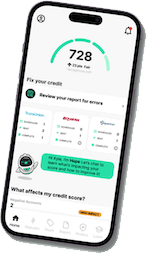Is a 672 Credit Score Good or Bad?

A 672 credit score is a solid starting point, falling in the “Good” range for FICO but “Fair” for VantageScore. While it’s not the highest score, it still gives you access to loans and credit cards—though at potentially higher interest rates. In this guide, we’ll break down what a 672 credit score means for your financial options and how Dovly AI can help you take control and improve your score.
Your credit score is a key factor in your financial health, impacting loan approvals, interest rates, and overall borrowing power. If your credit score is 672, you might be wondering whether it’s good, bad, or somewhere in between. In this guide, we’ll break down what a credit score of 672 means, how it impacts your ability to borrow, and what you can do to improve it.
What Can You Get With a 672?
A 672 is considered a “Good” credit score under the FICO scoring model but falls in the “Fair” range under VantageScore. As of early 2025, the average credit score is a 717 with FICO and a 702 with VantageScore.
While your credit score is not bad, it’s also not high enough to unlock the best rates and credit offers. You can probably still get a loan or credit card, just be prepared for higher rates.
Below is a breakdown of how different types of credit may be affected by your score.
Credit Cards
- You are likely to qualify for unsecured credit cards, but your credit limit may be lower, and your interest rate may be higher than someone with a score above 700.
- Some rewards credit cards may be available, but the best cash-back and travel rewards cards often require a credit score of 700 or higher.
- You may be required to pay an annual fee to access better credit card offers.
Auto Loans
- With a 672 credit score, you can likely qualify for an car loan, but your rate will be higher than someone with excellent credit.
- To compensate for the risk of lending to someone with a fair credit score, some lenders may require a higher down payment.
Mortgages
- You may qualify for FHA loans, which allow for lower credit scores and smaller down payments, but if you want a conventional loan, you may face higher interest rates.
- Borrowers with credit scores above 700 generally receive the best mortgage rates.
- If you are applying for a VA loan or USDA loan, a 672 credit score is usually high enough to qualify, assuming other financial factors are in good shape.
Personal Loans
- You can likely qualify for a personal loan, but lenders may offer you higher rates, typically between 10% and 20%.
Student Loans
- If you are applying for federal student loans, your credit score does not impact your approval.
- Private student loans, however, often require a higher credit score for the best rates.
What Makes Up a Credit Score and How It’s Calculated
Your credit score is a numerical representation of your creditworthiness and financial health—basically, how responsible you are with borrowing and repaying money. Lenders use scores to assess risk before approving you for loans, credit cards, or other financial products. The information from your credit report is what determines your credit score.
There are multiple credit scoring models, but the two most commonly used are:
- FICO Score (Fair Isaac Corporation) – Used by 90% of top lenders.
- VantageScore – Another popular model, used by some banks, credit card issuers, and other financial institutions.
Both credit scoring models have credit score ranges from 300 to 850, higher indicating lower risk to lenders. However, they weigh factors slightly differently, which can cause variations in your credit score across models.
What Factors Affect Your Credit Score?
Though different models may use slightly different calculations, the five core factors that impact your credit are generally the same and are all gathered from your credit report.
Payment history tracks whether you make timely payments on your bills, including credit cards, loans, and even some utility or rent payments if they’re reported. Late or missed payments, as well as accounts sent to collections, can significantly hurt your positive credit history and lower your score.
Amounts owed, also known as credit utilization ratio, measures how much of your credit card account you’re using compared to your total credit limit. A lower utilization ratio is better for your score, with the general rule being to keep it below 30%, while staying under 10% is ideal for maximizing your score.
Length of credit history plays a role in determining your score, with longer credit histories being more favorable. Factors such as the age of your oldest account, the average age of all your accounts, and how long specific accounts have been open are all considered. Closing old accounts can reduce your average account age or credit history, which may lower your credit score.
Credit mix refers to the variety of credit accounts you have, including revolving credit, like credit cards and lines of credit, and installment loans, such as car loans, mortgages, and student loans. While this factor has less impact than others, having a diverse mix of credit types can demonstrate to lenders that you can responsibly manage different kinds of debt.
New credit inquiries occur when you apply for new credit, leading to a hard inquiry that can slightly lower your score by a few points. Too many hard inquiries in a short period may signal financial distress and make lenders cautious. However, soft inquiries, such as checking your own credit score or getting pre-approved, do not affect your credit.
Credit Score Ranges & What They Mean
Both FICO and VantageScore categorize credit scores into different risk levels. Here’s how they break down:
| Score Range | FICO Category | FICO Meaning | VantageScore Category | VantageScore Meaning |
|---|---|---|---|---|
| 800 – 850 | Exceptional | Best rates, lowest risk to lenders. | Excellent | Low risk to lenders, best rates. |
| 740 – 799 | Very Good | Qualifies for most loans with competitive rates. | Falls within Good | Can qualify for most loans, but not always best rates. |
| 670 – 739 | Good | Considered an acceptable borrower, but not the best rates. | Good (661-780) | Can qualify for most loans, but not always best rates. |
| 580 – 669 | Fair | Higher rates, may struggle with approvals. | Fair (601-660) | Some lenders may approve, but with higher interest rates. |
| 500 – 579 | Poor | Difficult to get approved; may need secured credit or co-signers. | Poor (500-600) | Many lenders will deny applications. |
| 300 – 499 | Very Poor | Not used in FICO categories | Very Poor (300-499) | Likely requires secured credit or major improvement before approval. |
How to Improve a 672 Credit Score
A 672 credit score is solid! Mostly classified as a good credit score, but a higher credit score can help you access better financial opportunities. A small increase in your credit score can save you thousands of dollars in interest payments over time.
1. Pay All Bills on Time
Since payment history makes up the largest portion of your credit score, missing even one payment can cause a significant drop. Setting up automatic payments or reminders can help ensure you never miss a due date.
2. Lower Your Credit Utilization
Keeping balances below 30% of your total credit limit can help improve your credit score. You could even ask for a credit limit increase to help too.
3. Dispute Errors on Your Credit
Errors on your credit report can lower your credit score. Reviewing your credit report with each credit bureau regularly and disputing any inaccuracies can help improve your score quickly.
4. Avoid Opening Too Many New Accounts
Every time you apply for credit, the credit bureaus record a hard inquiry on your report, which may temporarily lower your credit score. Too many inquiries in a short period can make you look risky to lenders.
5. Keep Old Credit Accounts Open
The length of your credit history impacts your credit score. Closing old accounts can reduce your average account age, which may lower your score. If you no longer use a credit card, keeping it open with a small balance can help maintain a higher score.
6. Diversify Your Credit Mix
A diverse credit mix, including credit cards, auto loans, and mortgages, can positively impact your credit score over time. However, you should only take on new credit if it makes financial sense.
7. Consolidate Credit Card Debt
If you have multiple high-interest debts on your credit report, consolidating them into one lower-interest loan or balance transfer card can help lower your credit utilization, which may boost your score.

Conclusion
While considered a good credit score, you can still qualify for credit cards, loans, and mortgages. However, you may face higher interest rates or stricter approval requirements. A 672 credit score is a solid foundation, but there’s room for improvement if you want better financial opportunities. By making on-time payments, lowering your credit utilization, and monitoring your credit report for errors, you can boost your score and access better financial products in the future.
Need help improving your credit? Dovly’s AI-powered credit engine can guide you through the dispute process and help you take control of your financial future. Enroll today!
Frequently Asked Questions




